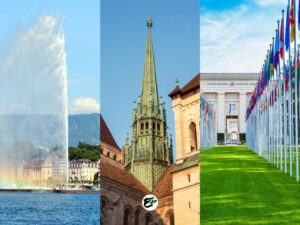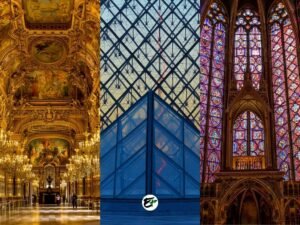Why Bamberg is Worth Visiting: A Guide to Top 12 Experiences
Besides Wurzburg, Rothenburg ob der Tauber, and Nuremberg, Bamberg is another town in Franconia I always recommend. Especially for my friends who enjoy visiting towns that are rich in beautiful architecture, historical sites, and panoramic landscapes.
Given the affectionate names people use for Bamberg — “Little Venice,” “Rome of Germany,” and “Seven Hill City” — you can already get an idea of why I recommend Bamberg.
While these names might make it seem like Bamberg is simply another version of famous European destinations, it’s unique in several ways. Most notably, it’s the town’s beer culture and tradition that sets it apart. These traditions are almost as old as the city itself, dating back more than 1000 years.
After exploring, I’ve discovered quite a bit about Bamberg, and I’m excited to share everything I know about this beautiful town in this post. I’ve compiled my findings into five compelling reasons why Bamberg is a must-visit destination and twelve activities that you can engage in during your visit to Bamberg.
This post contains affiliate links. I may receive a tiny commission at no additional cost to you.

Use the table of contents to skip to topics.
Summary
Currently, Bamberg is recognized as one of Germany’s top attractions and is definitely worth a visit. Its old town, a UNESCO Heritage site, is a remarkable example of an early medieval town in central Europe. Travelers can explore Bamberg by visiting its Altes Rathaus, taking a gondola ride in the town’s Little Venice, tasting its unique smoked beer, and visiting beautiful landmarks in and around the town.
If your travels are inspired by the beauty of a place, the photos below will provide a glimpse of the stunning scenery that awaits you in Bamberg.
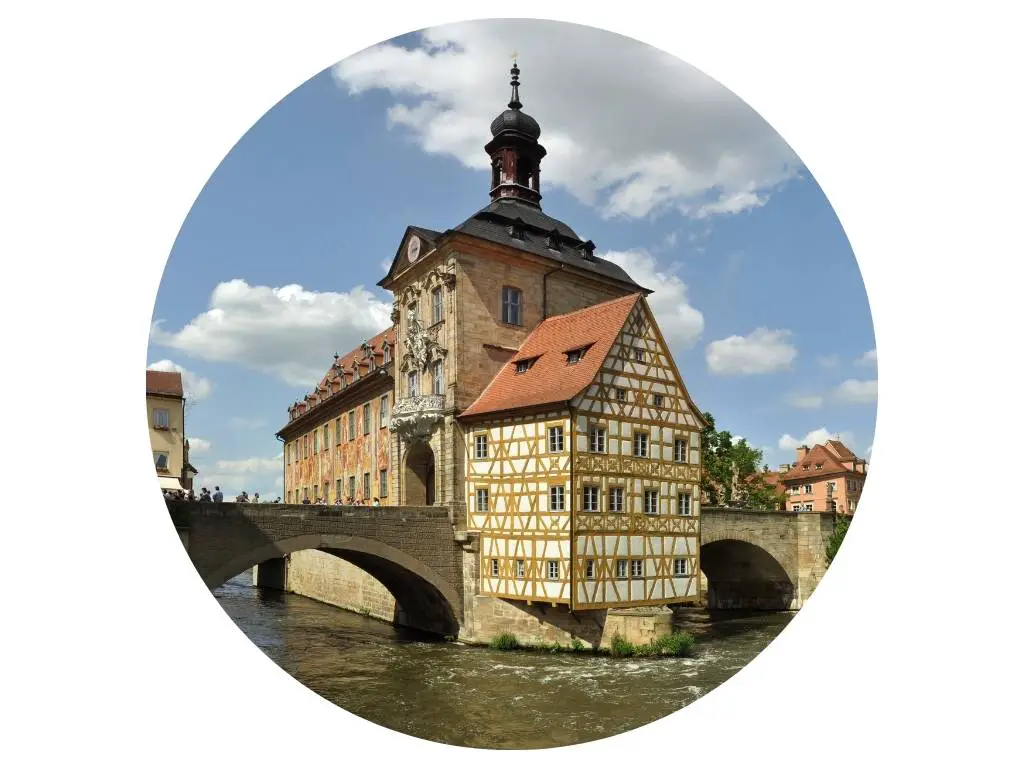
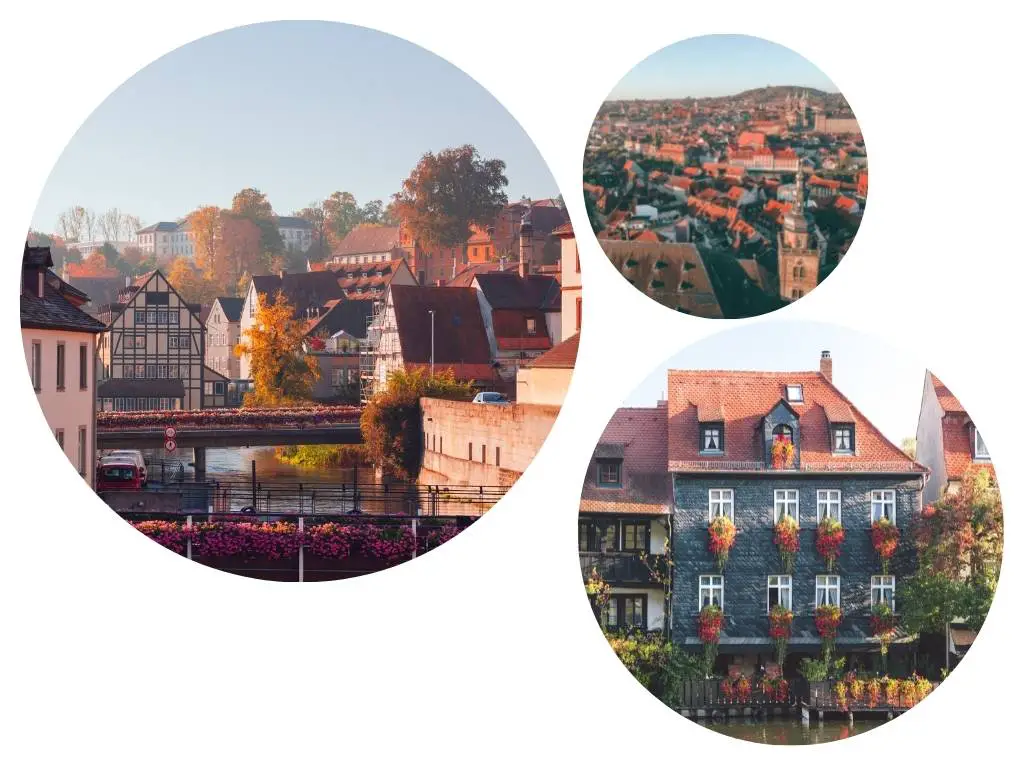
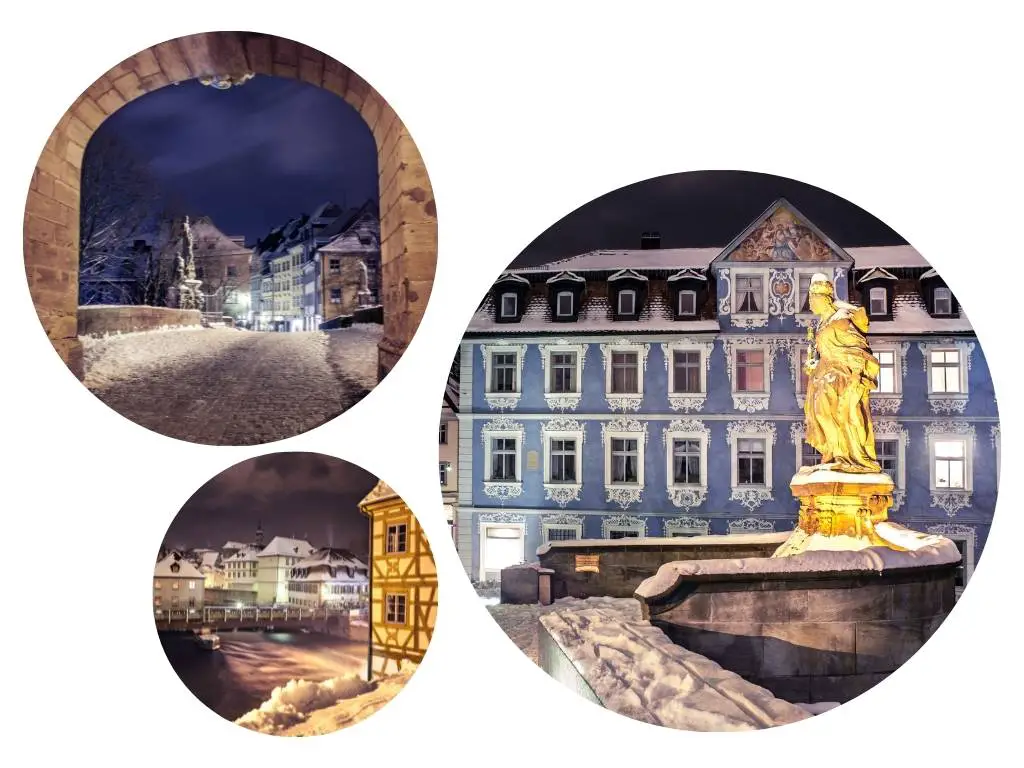

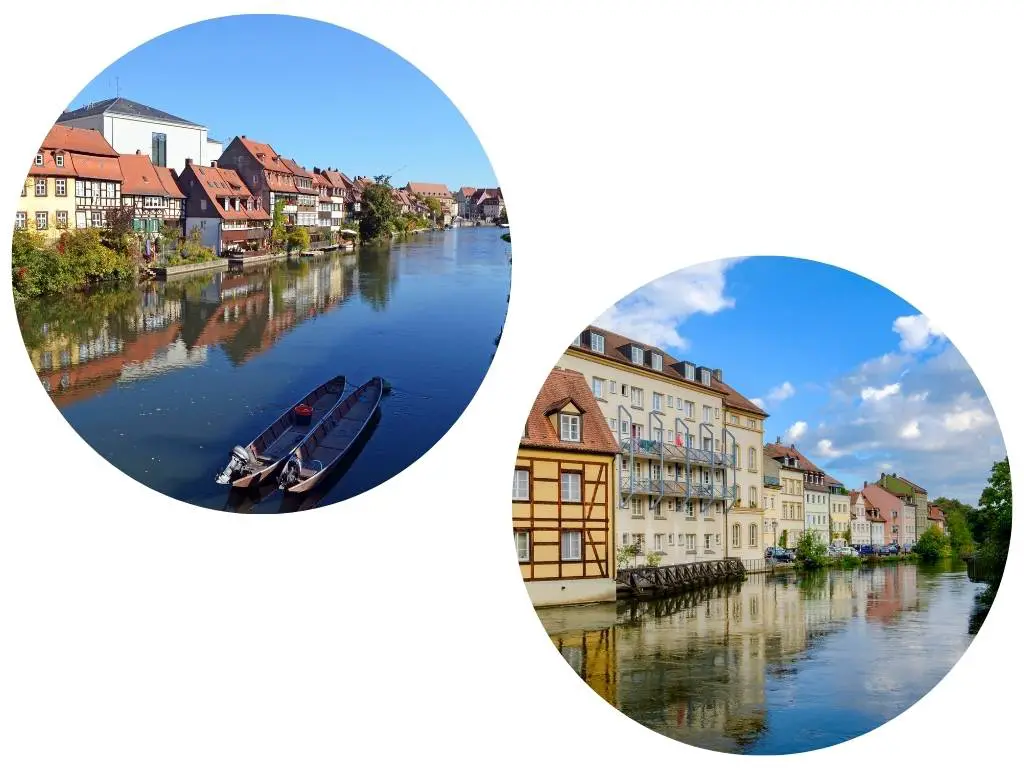
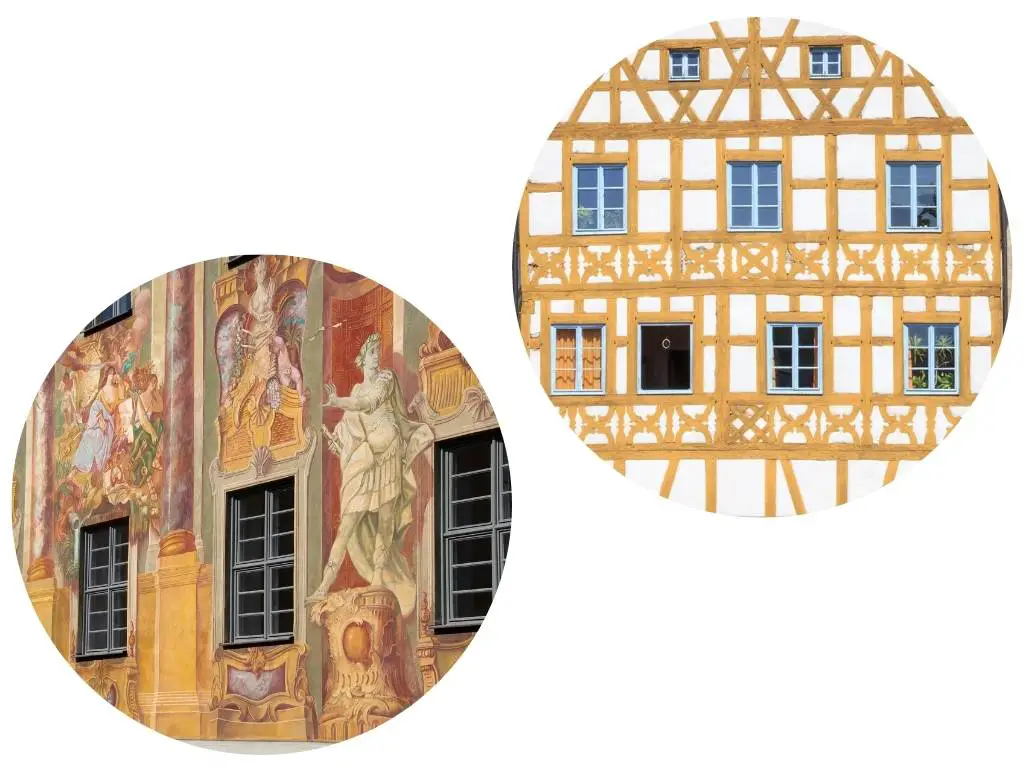
If you’re planning to spend a few days or more in Bamberg, consider these excellent hotel deals. For a more insightful visit to Bamberg, I recommend joining at least one cultural tour.
I. To Immerse Yourself in the Medieval Atmosphere of Bamberg’s Old Town
During a visit to Bamberg, the medieval charm of the town is unmistakable, particularly in its old town, or Altstadt. Like, you can simply visit Domplatz and wander as the cathedral bells ring—goosebumps will certainly crawn over your skin! Have no doubt. The medieval experience in Bamberg is preserved and is recognized by UNESCO.
Learn more about the architecture and history of Bamberg and Bamberg’s UNESCO status.
Bamberg has been recognized as a UNESCO World Heritage Site due to its distinctive features and historical importance. The town stands as an exceptional example of a central European town with a primarily early medieval layout, and it has successfully preserved numerous ecclesiastical and secular buildings from the medieval era.
Starting from the 10th century, Bamberg served as a vital connection with the Slav peoples, especially those from Poland and Pomerania. Its architecture, which flourished from the 12th century onwards, had a significant impact on northern Germany and Hungary.
In the late 18th century, Bamberg emerged as a center of the Enlightenment in southern Germany. It attracted renowned philosophers and writers such as Georg Wilhelm Friedrich Hegel and E.T.A. Hoffmann. The layout and architecture of medieval and baroque Bamberg profoundly influenced urban form and evolution in central Europe from the 11th century onwards.
Today, the city’s medieval layout, with its three settlement areas, remains well preserved. The street layouts of the three historic core areas have retained their medieval characteristics. Since the 1950s, Bamberg has been dedicated to a continuous program of restoration of its historic properties and areas. The preservation of the town is ensured by the laws and regulations of the Federal Republic of Germany and the Free State of Bavaria.
To truly appreciate the medieval charm of Bamberg, there are four places in the town that you should not miss: the Cathedral, Neue Residenz, Alte Hofhaltung, and River Regnitz (and the landmarks along it). These locations are the architectural highlights of Bamberg and are ideal for a relaxed day trip to the town.
1. Visit Bamberg Cathedral
The Bamberg Cathedral is one of the oldest and most striking structures in Bamberg.
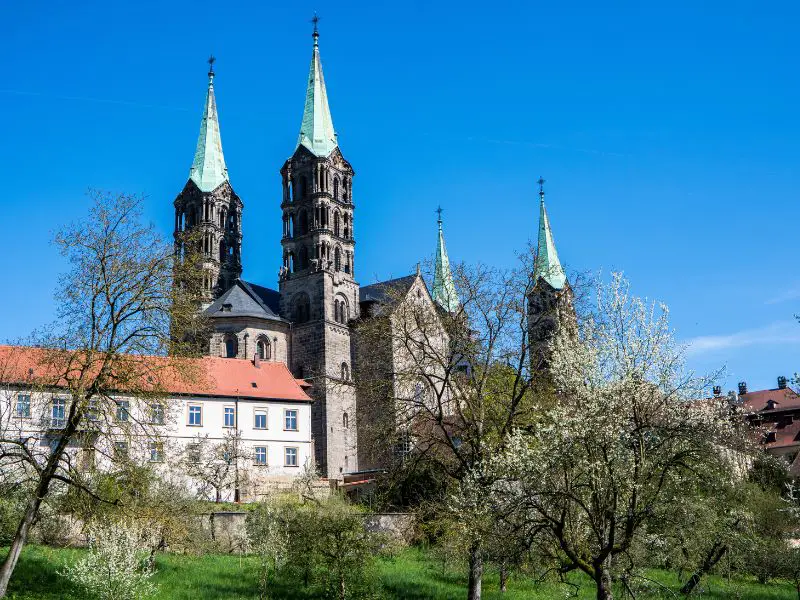
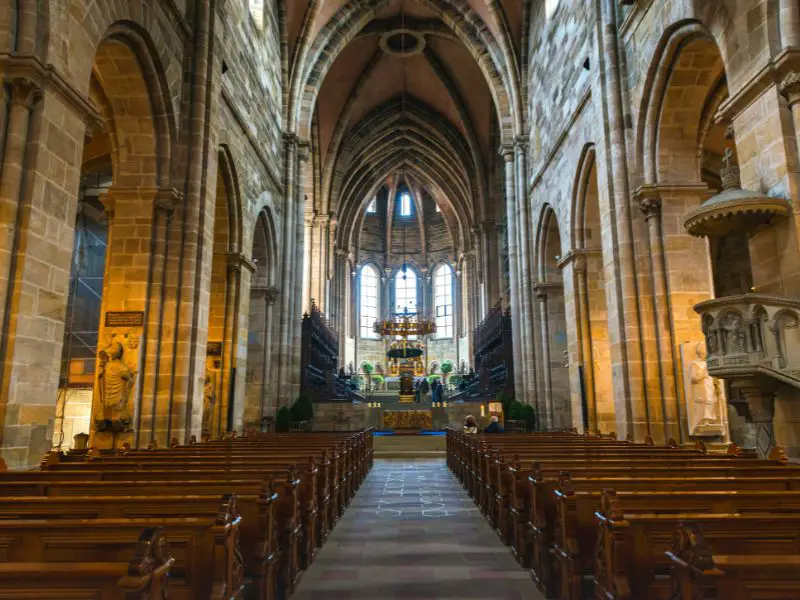
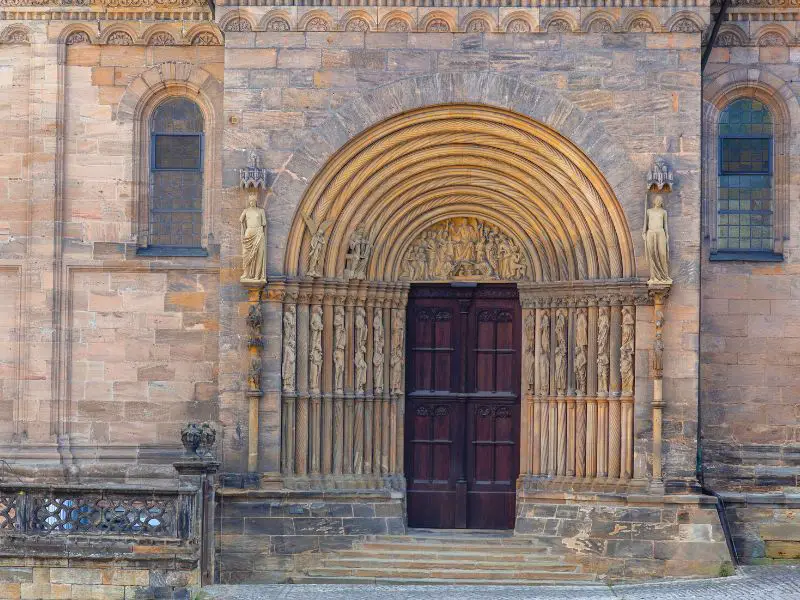
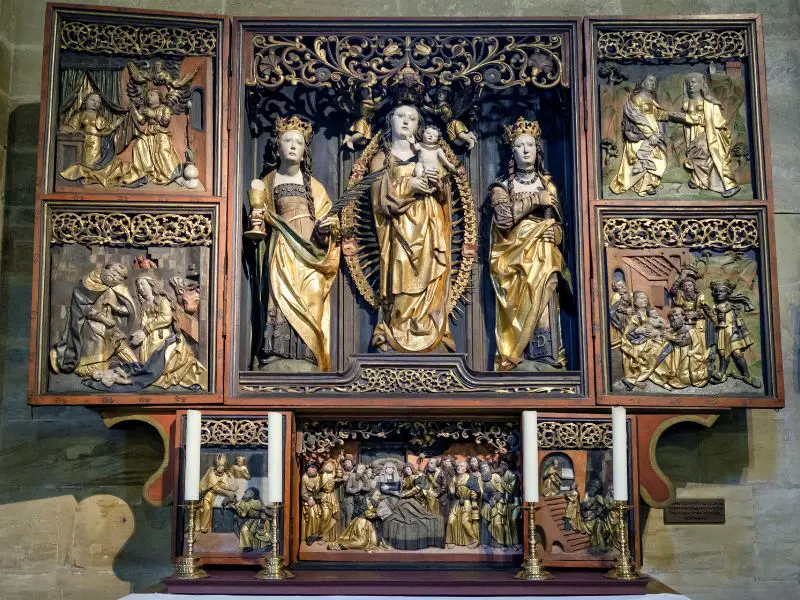
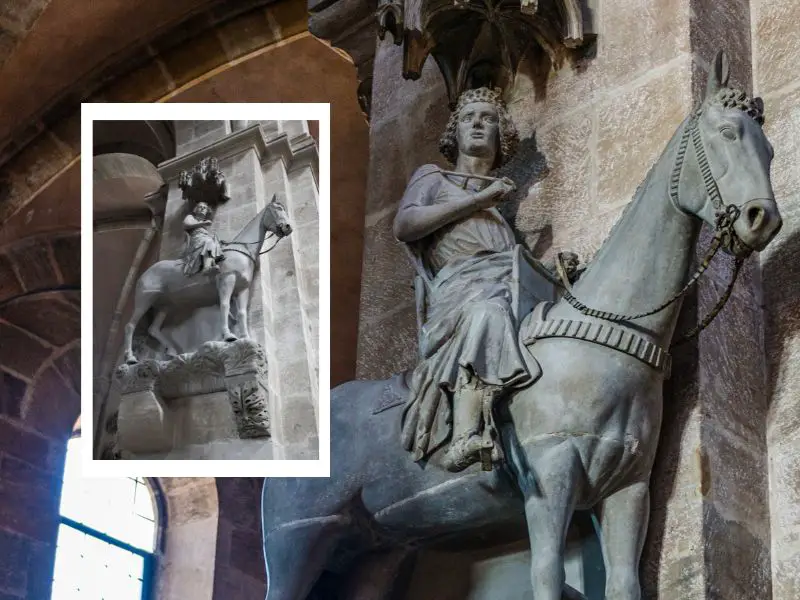
This impressive church, situated atop one of the town’s seven hills, was initially founded in 1002. However, it was ravaged by fire a few centuries later. What we see today is its 13th-century version, which predominantly features two architectural styles: Gothic and Romanesque. These styles were incorporated throughout the cathedral’s development.
The four towers of the cathedral, clearly visible from the cathedral square, are testament to these styles. Two of the towers showcase Romanesque architecture (east), while the other two feature Gothic architecture (west). If you time your visit on the hour, you’ll hear the bells chime from these towers. It is an amazingly eerie experience, especially during off-peak hours.
Inside the church, you’ll find remarkable artworks, from fascinating sculptures and carvings adorning the portals to the church altars. Even if you’re not Catholic, the Bamberg Cathedral is certainly worth a visit.
Two of the cathedral’s most notable artworks are the Tomb of Emperor Heinrich II and Empress Kunigunde, and the Bamberg Horseman. The tomb, a masterpiece created by the famous Tilman Riemenschneider, took 14 years to complete. The intricate details and the stories it depicts make it a truly admirable piece of art.
The Bamberg Horseman is another treasure of the cathedral. Images of this equestrian statue can be found in many places across Germany, such as schools and homes. The statue has been interpreted in various ways over time. Some believe it symbolizes German perfection, while others think it’s an image of the Hungarian King Stephen I. However, its true meaning remains unknown.
You can plan your visit by referring to the visiting information available on the official website of the Bamberg Cathedral.
2. Explore Neue Residenz & Rose Garden
Across the cathedral square, the Neue Residenz in Bamberg comes into view, representing the peak of baroque grandeur in the city.
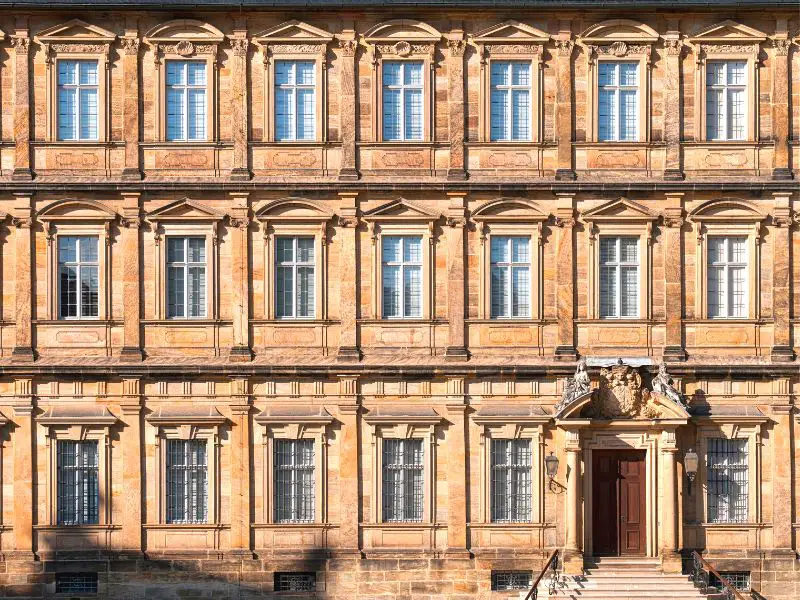
This multi-winged, heritage-protected building located on Domplatz served as the bishop’s residence of the Bamberg prince-bishops from 1604. It replaced the Alte Hofhaltung on the other side of the square in this function. Today, it houses the state library and the state gallery of Bamberg.
As you step into the Neue Residenz, you’ll be transported back in time. The mansion is adorned with stunning rococo design, fresco and stucco ceiling decorations that will give you a sense of royalty. The walls are decorated with 17th to 18th-century artworks and portraits, satisfying your artistic desires.
The Neue Residenz is home to more than 40 magnificent rooms. The Marble Hall, the Mirror Room, and the Emperor’s Hall are among the most notable.
The Emperor’s Hall, one of the most significant late Baroque room artworks in Franconia, is located on the second floor of the central tract. Its ceilings and walls were adorned with frescoes in the painting style of Pietro da Cortona by Melchior Steidl between 1707 and 1709.
Aside from exploring these rooms, immersing yourself in the history of the place, and admiring the artwork, you should also not miss the chance to visit the Rose Garden of the Neue Residenz. It is a remarkable spot that offers a blend of natural beauty, architectural elegance, and panoramic views.
Divided by two intersecting paths with a round fountain pool at the center, the garden is home to around 4,500 rosebushes of 50 different varieties. The beds, edged with low box hedges, create a simply visual spectacle (especially during autumn) that is so nice and calming.
Adding to the garden’s charm is the Rococo Garden pavilion, built in 1756/57, probably from designs by Michael Küchel. This architectural gem now serves as a café, offering a place to relax and soak in the surroundings.
But perhaps the most notable feature of the Rose Garden is the breathtaking view it offers of Bamberg’s old town and the Michaelsberg with its former Benedictine monastery. From the balustrade of the Rose Garden, you can enjoy this panoramic vista, making your visit to the Neue Residenz a memorable experience.
To plan your visit to the Neue Residenz, consult the visitor information on its official website.
3. See Alte Hofhaltung
The Alte Hofhaltung (Old Court) is perhaps the most intriguing architectural attraction in the old town of Bamberg. You can find it and enter through the gate located on the western side of Cathedral Square (Domplatz).
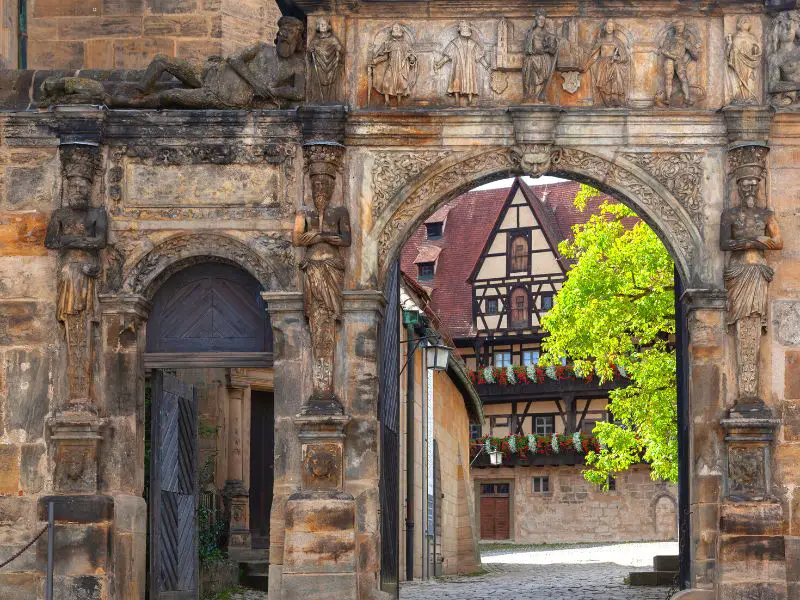
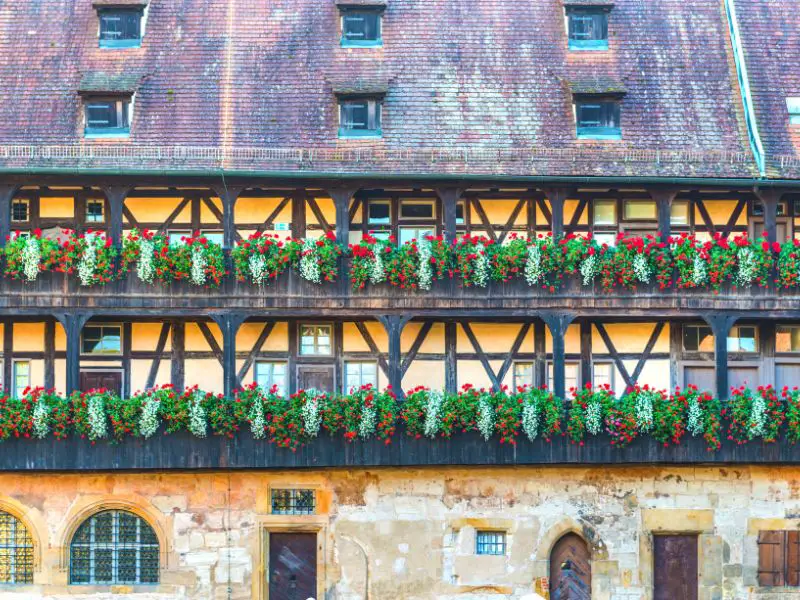
This Renaissance-style structure, built on the site of the former Castrum Babenberg, served as the residence of the bishops who worked in the cathedral. Some of the houses in the complex date back to the 11th century
The Old Court’s Gate, also known as “The Beautiful Gate,” greets visitors with an unusual, somewhat daunting charm. Despite its dedication to the saints, the ancient appearance of the Old Court Gate and the mythical creature’s head beneath the arch can send shivers down visitors’ spines.
Upon passing through the gate, you find yourself in a charming square surrounded by timber-framed buildings. These structures once served as the residences of the bishops who worked in the cathedral, with some of the houses dating back to the 11th century.
The Old Court’s medieval ambiance has caught the attention of several filmmakers, making it a popular filming location. If you’ve seen the movie “The Three Musketeers,” you might recognize this place.
The complex is home to the Historical Museum of the city of Bamberg, where you can immerse yourself in the city’s rich history. The museum’s exhibits provide fascinating insights into Bamberg’s past, making your visit both educational and enjoyable.
Check the visiting information on the official website of Old Court Gate and Bamberg Historical Museum.
4. Try the Romantic Gondola
A boat ride over the rivers of Bamberg is a unique way to experience the medieval charm of Bamberg, reminiscent of Venice.
Like in Venice, you’ll be in a gondola, an experience that combines history, architecture, and natural beauty. If you’re with your significant other, it can also be quite romantic! The entire journey along the river takes about 30 minutes, covering various parts of Bamberg, from Little Venice to the Regnitz meadows.
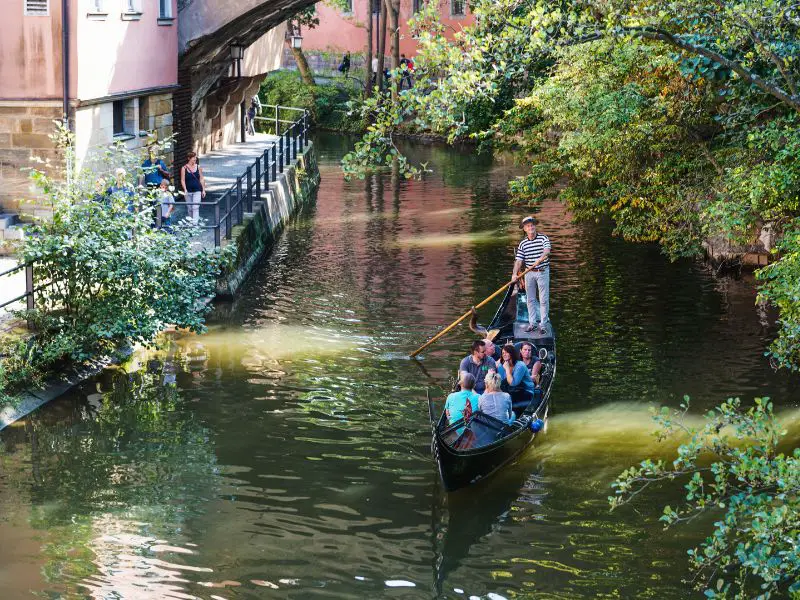
During the boat ride, you’ll see things from different perspectives. For me, the highlights of the gondola ride include passing by the picturesque half-timbered fishermen’s houses, drifting under the bridges, and observing the locks in action.
If the gondola ride is not available, there are several other water activities you can try for a unique experience of Bamberg from the river. Boat excursions in Bamberg occur several times a day, covering areas beyond those reached by the gondola ride. The best part of these boat excursions? You’ll get a unique view of Saint Michael’s Hill with its abbey on top.
If you’re interested, you can try the Pettstadt Ferry, the oldest ferry of its kind in Upper Franconia. This ferry experience dates back to the 14th century!
Here’s the official website of Bamberg where you can find details about the water activities in Bamberg.
II. To Marvel at the Iconic Town Hall of Bamberg
If Bamberg has a historical landmark that distinguishes it from other cities in Germany, it would be its town hall. This structure is another highlight in the town, impossible to miss due to its unique stunning appearance and intriguing history. It stands in the middle of the Regnitz River, serving as a boundary marker between the clerical, bishop-led Bamberg and the civil town center.
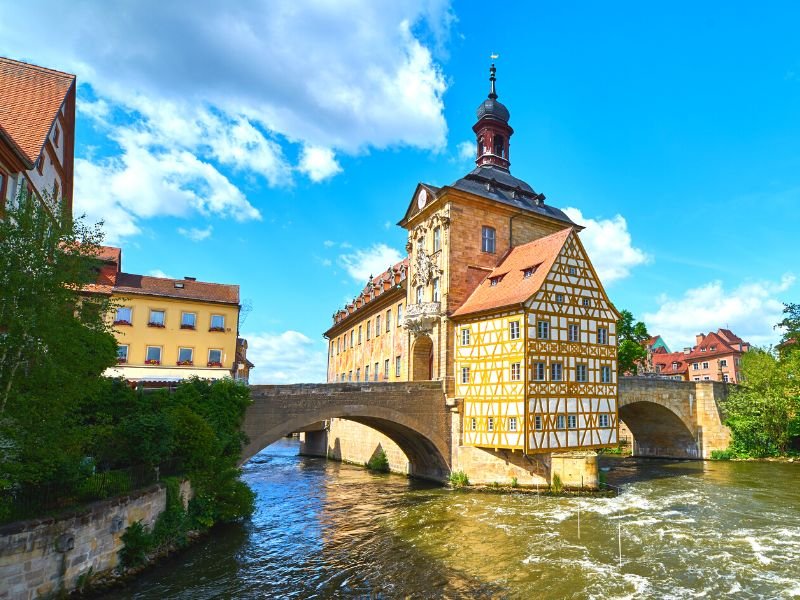
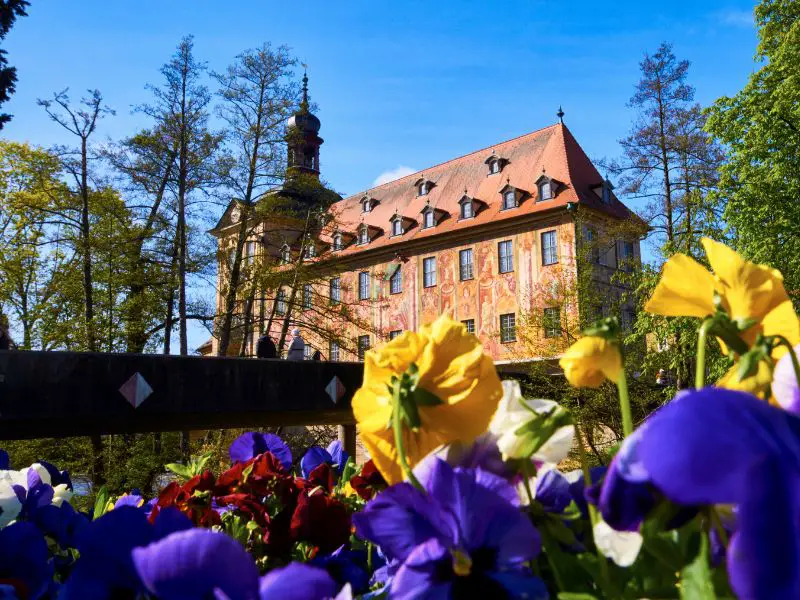
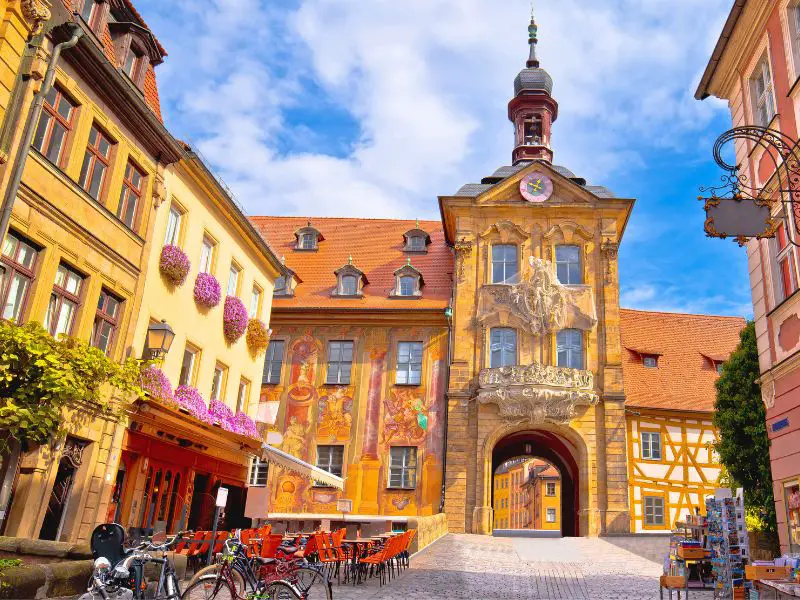
About its history—the story of the Old Town Hall is quite intriguing.
It’s said that when the bishop refused to grant the citizens of Bamberg any land for the construction of a town hall, they took matters into their own hands. They drove hundreds of oak piles into the riverbed and piled up gravel, sand, and earth until they had created an artificial island.
On this island, they built the town hall they so desired. The first mention of Bamberg’s town hall dates from 1386, but the building was destroyed in a fire in 1460. The building that stands today was erected in 1461.
Today, the Old Town Hall is more than just a symbol of the city. It houses the prestigious rococo hall and the Ludwig Collection, making it a major tourist attraction.
Architecturally, the Old Town Hall is a beautiful half-timbered house. The façade is adorned with magnificent frescoes created by Johann Anwander in 1755. These frescoes lend the facades a three-dimensional quality achieved with trompe d’oeil architecture. They depict recreated scenes and architectural details, leaving a sculptural impression on the viewer.
During your visit, make sure to view the Old Town Hall of Bamberg from various perspectives. Aside from the Obere Brücke connects the Old Town Hall to the rest of the town and offers a unique viewpoint, consider exploring the views from the Untere Brücke, the bridge located behind the Old Town Hall.
Of course, don’t miss the view from Geyerswörthsteg, where the Old Town Hall’s position in the middle of the river is clearly visible.
5. Marvel Explore the Museum Inside the Town Hall
As its exteriors already tells, the Old Town Hall in Bamberg is a repository of art and history.
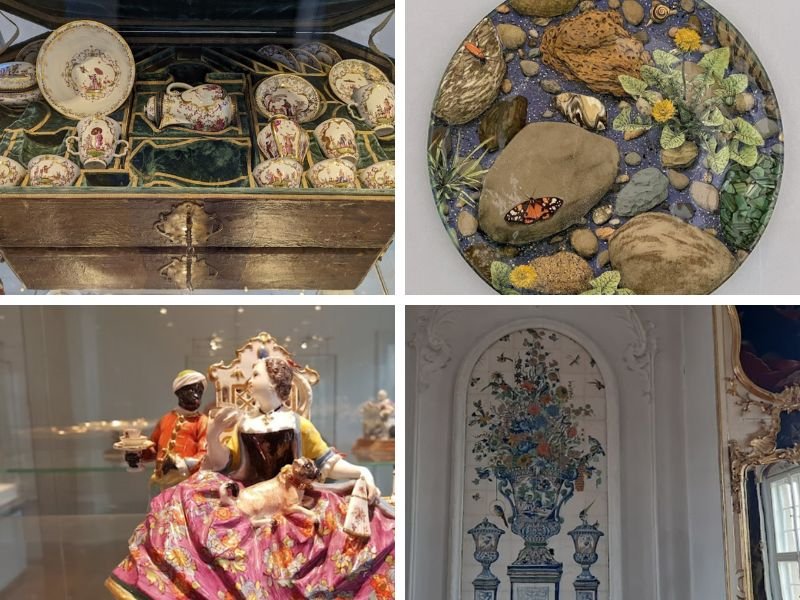
It is home to the Ludwig Bamberg Collection, which showcases the evolution of porcelain, often known as “white gold”. The collection traces the development of porcelain, from Böttger’s initial stoneware, through the early porcelain mixtures with alabaster, to the final recipe that is still used today.
The exhibits reflect the extravagant lifestyle and sophisticated table culture of the 18th century. They feature intricately crafted figures that once graced the tables of that period. The collection also includes tureens shaped like animals, a playful yet refined tribute to the era’s interest in the natural world.
Scented vessels, their fragrances long gone but their beauty enduring, are also part of the collection. Moreover, there are services for coffee, tea, and chocolate that mirror the luxurious lifestyle of the time.
For information on visiting, please consult the official website of Bamberg’s Museums.
III. To Find Little Gems in Bamberg
Like other medieval towns in Europe, exploring Bamberg entails stumbling upon little gems like houses with intricate facades, cute fountains adorned with flowers, or statues that are about the history of the place.
Honestly, before I explored Bamberg, I thought that once I had seen the highlights of the town (in the Mountain Town and Island Town districts), there wouldn’t be much else to discover. However, I soon realized that the city had more to offer.
There are numerous intriguing sites scattered throughout the city. As you wander through the town, you’ll find yourself unexpectedly coming across these hidden gems. Each discovery brings with it a small thrill of surprise!
In case you’re not familiar, Island Town is the district home to the Old Town Hall and Little Venice. Mountain Town, on the other hand, is the part of Bamberg where the Bamberg Cathedral, Hofhaltung, and Neue Residenz are located.
6. Beautiful Fountains, Sculptures, and Buildings
In addition to the highlights of Bamberg, you can discover small, beautiful elements like fountains and buildings with attractive appearances.
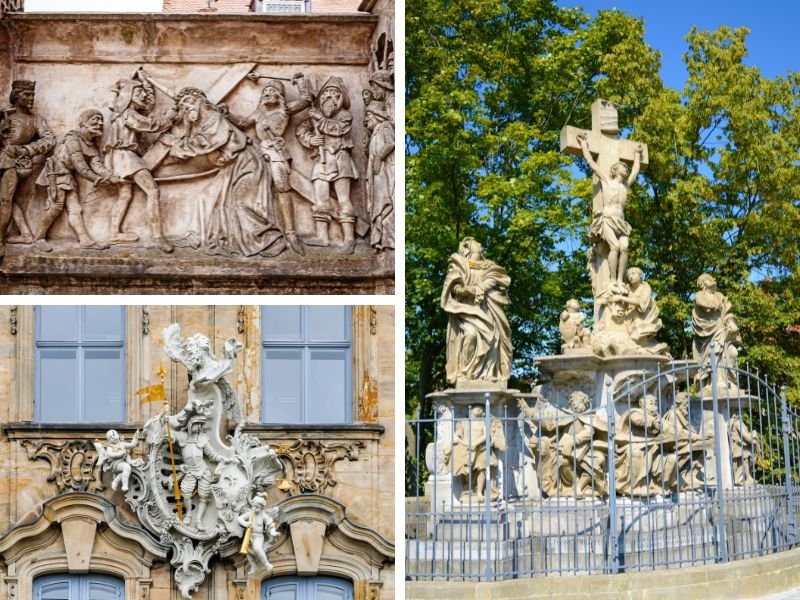
As you wander through the Old Town of Bamberg, you may come across relief sculptures that depict the Stations of the Cross. This series of relief sculptures begins in front of the portal of St. Elisabeth with the house of Pilate, where Christ takes up his cross, and ends inside St. Getreu church with the scene of the crucifixion and entombment of Christ.
Another sculpture you might enjoy as you explore Bamberg is the statue of Queen Cunigunde located behind the Old Town Hall.

She is one of the most charming and attractive statues in the streets of Bamberg, smiling at you as you walk through Untere Brücke. The statue depicts her holding a golden scepter and wearing a golden crown adorned with a cross. This spot, with Klein Venedig, or Little Venice, in the background, is a popular place for photographs.
Interesting fact: Queen Cunigunde of Luxembourg, who lived from around 980 to 1033, ruled the East Franconian-German empire after the death of her husband, Heinrich II. In 1200, the Roman Catholic church canonized Cunigunde, and she became a beloved figure in Franconia, particularly in Bamberg.
Another sculpture you might find interesting is the statue of Neptune in Neptunbrunnen, a baroque-style fountain located on the Green Market.
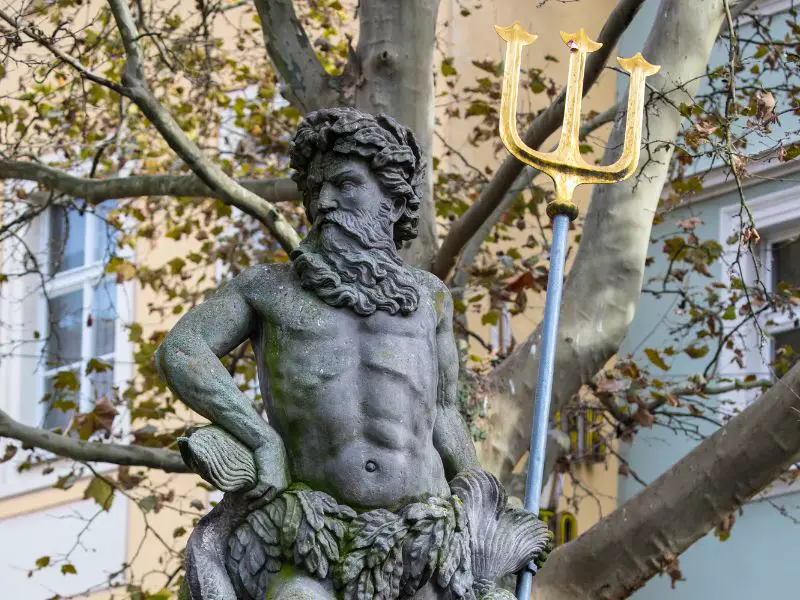
The fountain features a statue of Neptune, the Roman sea god, who is locally known as “Gabelmann” due to the golden trident he wields. The fountain has a captivating history dating back to its initial erection in 1337. Originally, it was topped with a figure of Saint George, the city’s knight, in 1566. The current statue of Neptune was added in 1698.
You might also want to visit Maximiliansbrunnen in Maximiliansplatz.
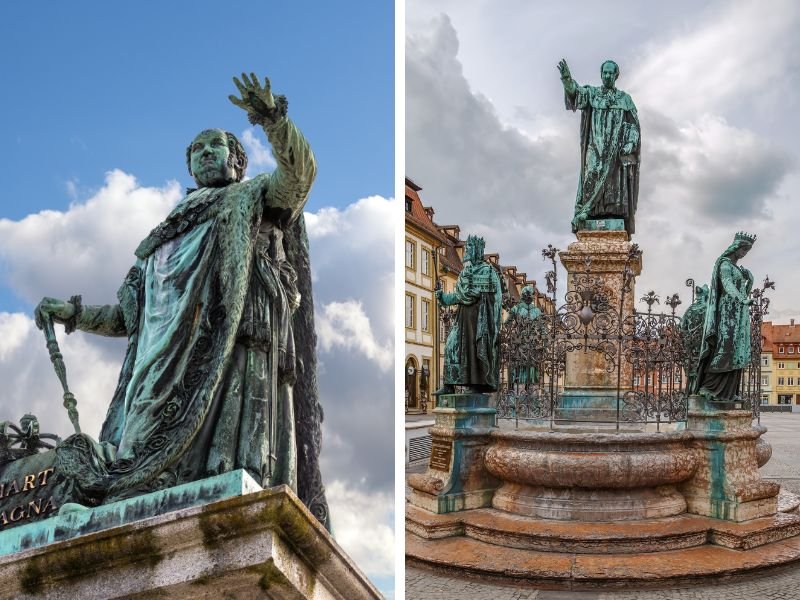
Created in 1888 by Ferdinand von Miller, the fountain is adorned with several statues, each representing significant figures for the city of Bamberg. At the top of the main fountain pillar stands King Max I. Joseph. Other figures include Heinrich II, the founder of the Diocese of Bamberg; Kunigunde of Luxembourg, Heinrich II’s wife; Otto I of Bamberg, a sainted bishop; and Konrad III, a German king who was born and died in Bamberg.
Interestingly, the statue at the Maximiliansbrunnen may have served as inspiration for a commemorative coin for the 900th anniversary of Heinrich II’s death in 1924.
If you’re interested in architecture, there’s a house in Bamberg that’s a visual delight: the Böttinger House. Its facade is stunning.

Located on Judenstraße, the Böttinger House, also known as the Prellshaus, is an early 18th-century city palace that stands as one of the most significant bourgeois baroque buildings in southern Germany.
The design of the building was inspired by Italian palaces, showcasing the wealth of Böttinger, who came from bourgeois circumstances. This building serves as a classic example of the rise of this social class in the 18th century.
7. Little Venice & Photography Spots
If there’s a gem in Bamberg that you should not miss, it’s Little Venice. Why? Simply put, it’s undoubtedly the most charming district in Bamberg.
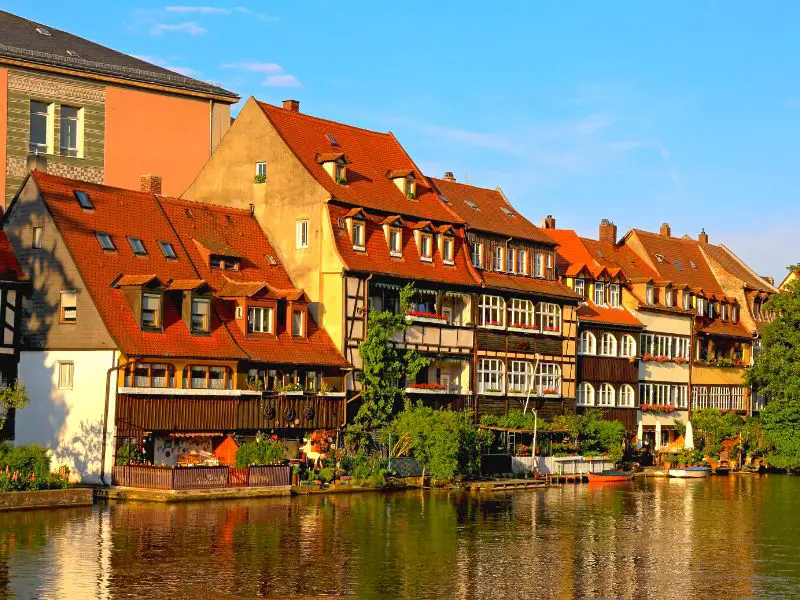
Little Venice was once a fishermen’s district in Bamberg’s Island City and is characterized by its half-timbered buildings, mainly built in the Middle Ages. These buildings, nestled together along the riverbank, create a quaint and picturesque scene with boats floating in the moorings by the front gardens.
The district earned its name “Little Venice” from two journalists in 1842, who were charmed by its unique architecture and serene river views. Despite having little in common with its famous Italian namesake, Little Venice is indeed worth seeing. It boasts a series of old 17th-century residences on the eastern banks of the Regnitz River, forming a unique line of houses that the river cruise takes you directly past.
If you’re visiting, a leisurely walk along the west bank of the Regnitz River provides an excellent view of Little Venice. For an optimal experience, begin your walk at the southern end of the Markussttrasse Bridge.
During calm weather, you might be lucky enough to see the reflections of these charming houses on the surface of the river. This riverside stroll could be particularly enjoyable during sunset. The golden hour light illuminates these west-facing timber-framed houses, enhancing their beauty.
IV. To Drink Bamberg’s Historic Beer & Visit Its Centuries-old Breweries
With nicknames like “The Rome of Germany” and “Little Venice,” you might think it would be better to visit Italy instead of Bamberg. However, that might change when you discover what else Bamberg is famous for — its Smoked Beers.
What makes these beers in Bamberg special is the traditional brewing and preparation method, honed over a thousand years of practice. Obviously, today, these beers are a significant reason to visit Bamberg. They make Bamberg a veritable paradise for beer lovers!
With more than 70 breweries in the city and county of Bamberg brewing over 400 kinds of beers, you wouldn’t want to leave Bamberg if you’re a beer enthusiast. It’s mindblowing to think: if you were to taste one type of beer a day, you would need to stay in Bamberg for more than a year!
The town even has a brewery trail that you can follow to taste the best of Bamberg’s beers. Some of the breweries included in the trail are Fässla, Keesmann, Schlenkerla, Spezial, Greifenklau, Ambräusianum, and Klosterbräu. To easily discover Bamberg’s beers, I suggest participating in at least one of the town’s guided tours.
8. Schlenkerla
According to popular opinion, Schlenkerla is the best place to visit in Bamberg for its famous Smoked Beer.
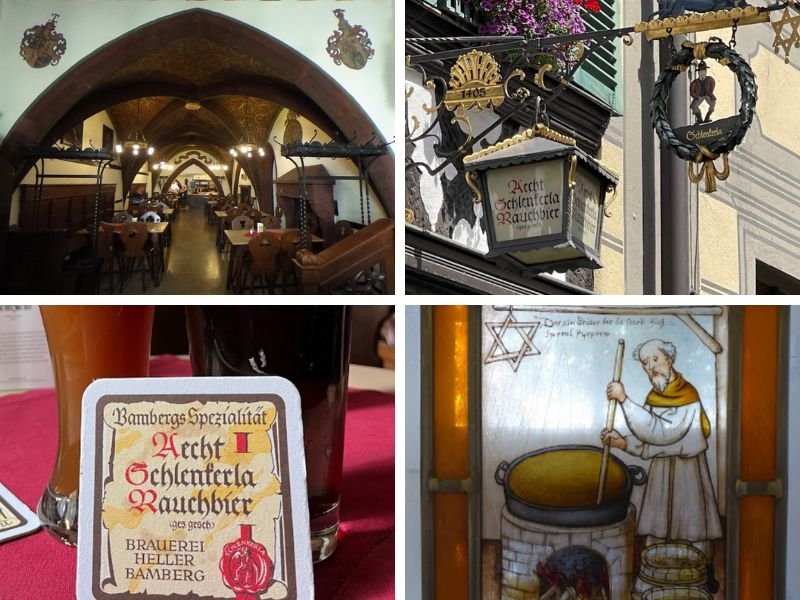
Schlenkerla, located in the heart of Bamberg, Bavaria, Germany, is a historic tavern renowned for its smoked Aecht Schlenkerla Rauchbier. Operating since 1405, it’s now run by the Trum family in the 6th generation.
What sets it apart is its traditional Rauchbier (smoked beer), tapped directly from the wooden barrel. The malt used in the beer is dried over an open flame, giving the beer a distinctive smoky flavor with a hint of malt sweetness. This unique taste, combined with the tavern’s rich history, makes a visit to Schlenkerla a memorable experience.
In addition to its famous smoked beer, Schlenkerla also offers a variety of other traditional beers, ensuring there’s something for every beer lover.
Schlenkerla has been winning numerous awards for its Smoked Beer since 1984. It has received gold awards from various beer festivals, including the Stockholm Beer Festival, the Australian Beer Awards, and the World Beer Cup.
If you’re interested in trying one of Schlenkerla’s smoked beers, I recommend checking the announcements on Schlenkerla’s official webpage first. This will provide you with information about their opening hours and any protocols they may have in place.
Finding Schlenkerla is straightforward. If you’re coming from Cathedral Square, it’s less than a three-minute walk. Head to the eastern section of the square where you’ll find a stairway. Descend the stairs and walk straight northeast. At the first intersection, turn right. The third house you’ll see is Schlenkerla.
9. Franconian Brewery Museum
The beers of Bamberg, and indeed Bavaria, are renowned worldwide. But have you ever wondered how they’re made? If yes, check out the Franconian Brewery Museum — a testament to the rich brewing tradition of the region.
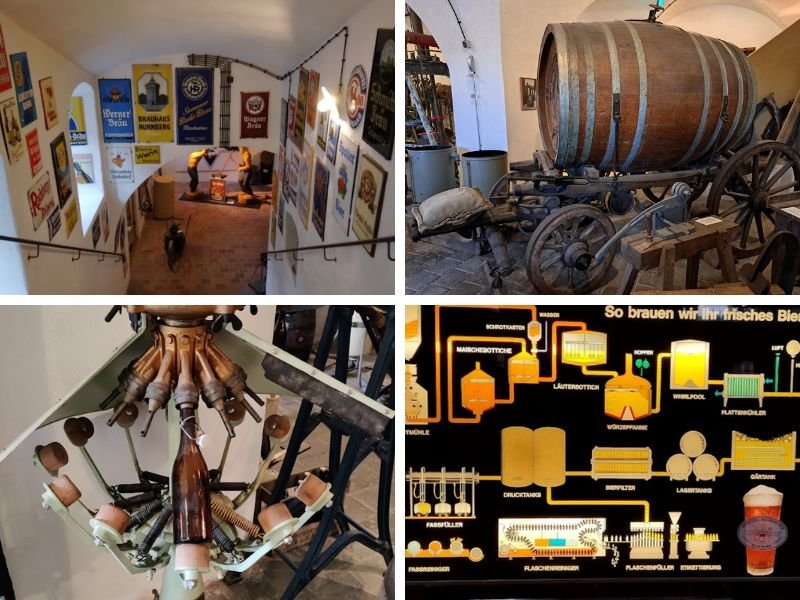
The Franconian Brewery Museum is a fascinating destination, housed in the historical vaults of the former Benedictine Abbey on the Michaelsberg. Established in 1984 by a group of professional brewers, the museum showcases over 1850 exhibits that trace the journey of beer from crop to mug.
As you explore the museum, you’ll encounter authentic stages of the brewing process, including the brewhouse, malthouse, fermentation and storage cellar, ice cellar, cooperage, filtration, barrel filling, and bottling.
Spanning over 1,000m² inside the magnificent vaults of a former monastery brewery, Franconian Brewery Museum offers a unique atmosphere for learning about this culturally significant beverage. Every part of the museum offers unique insights:
- Ground Floor: Here, you’ll find the Grist Mill (brewhouse) and Cooling Ship (beer distillery).
- Level 1: This level is dedicated to beer culture and features a collection of beer mugs.
- Level 2: On this level, you can learn about barrel and bottle filling, filtration, cooperage, and distillery.
- Level 3: This level houses the Malt House and exhibits on commodities like hops and cereals.
- Level 4: The final level showcases the fermentation process, storage cellar, and ice cellar.
Reaching the Franconian Brewery Museum from Domplatz is a short walk. The quickest route is through Ob. Karolinenstraße and Michelsbergerstraße, which should take no more than 15 minutes. For more information on visiting, please check the official website of the Franconian Brewery Museum.
V. To See the Views, Palaces, and Castles in Bamberg
Bamberg is worth a visit not only for its Old Town but also for the fun and visually pleasing experiences that extend beyond it.
Accessible from Bamberg are an abbey with a panoramic view, a castle that transports you back in time, and a stunning palace. These destinations are ideal for explorers and travelers seeking attractions off the beaten path. Situated atop a hill or within a forest, these sites also offer opportunities for relaxation in nature, such as hiking.
Now, let’s discuss each of these attractions in more detail.
10. Michaelsberg Abbey
Michaelsberg Abbey, prominently situated on a hill, is a historical gem visible from many parts of Old Town Bamberg. You can catch glimpses of it from the Rose Garden of the Neue Residenz and while cruising on the River Regnitz. Constructed in the early 11th century, it stands as one of Bamberg’s most historic structures.
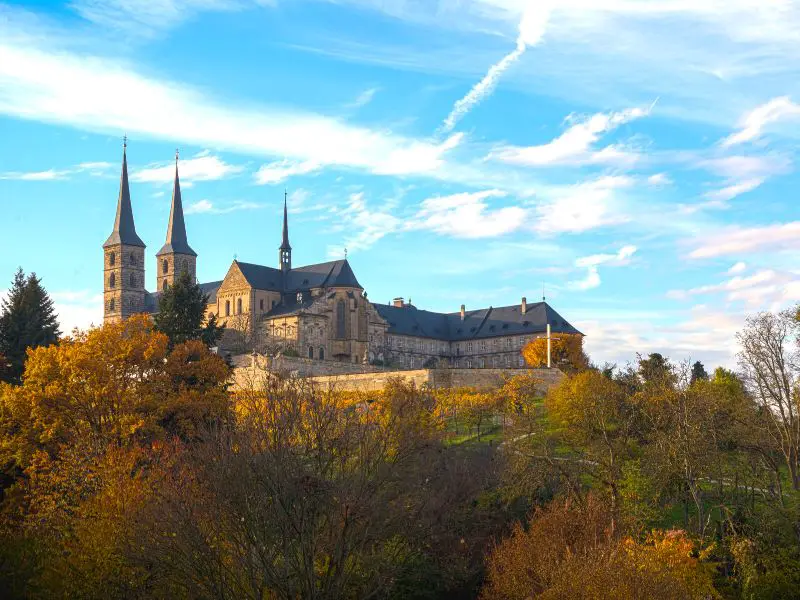
The Abbey has been the backdrop for numerous events throughout the Middle Ages and modern history, up until the secularization of Bavaria. It was once the residence of Bishop Otto, who was later canonized as a saint. Renowned craftsmen of the time, such as Balthasar Neumann and Ludwig Dietz, also worked here.
Today, Michaelsberg Abbey is home to the Franconian Brewery Museum. However, the Abbey offers more than just beer history.
It houses a magnificent church filled with artistic and religious treasures. These include the golden Gothic tomb of Saint Otto, adorned with sculpted images of a king, queen, and other saints; a neoclassical Holy Sepulchre; various paintings depicting Jesus; and a beautiful Rococo pulpit illustrating the triumph of Saint Michael, the archangel.
Michaelsberg Abbey also features a restaurant and a garden where leisure time can be enjoyed. This location offers a splendid view of the town from above. From these vantage point, the skyline of Bamberg is visible, stretching from the cathedral in the south to the villages in the north.
Following a meal, a stroll around the area to visit the Michaelsberg Garden, also known as the “celestial garden,” is recommended. The Michaelsberg Garden is a baroque terraced garden with a central fountain and boasts over 500 varieties of flowers. Two pavilions are tucked away in a corner of the garden, providing a tranquil spot for quiet reflection.
Here is the official website of Michaelsberg Abbey for more information such as opening hours, access, and more.
11. Altenburg
Altenburg Castle, majestically situated on the highest of Bamberg’s seven hills, is one of Bamberg’s most beautiful off-the-beaten-path destinations.

The castle’s history is as old and quaint as its architecture, with its first mention in historical records dating back to the early 11th century. During times of danger, the castle served as a refuge for the townsfolk. It wasn’t until 1251, when the bishops of Bamberg acquired the castle, that it became a permanent residence.
Today, Altenburg Castle serves multiple purposes. It is open for public tours, allowing visitors to explore its rich history and enjoy the panoramic views of Bamberg.
Upon your arrival, you’ll be greeted by a picturesque castle keep fortified by a wall, a roofed ramparts walkway, the imposing Altenburg tower, old wells adorned with beautiful metal railings, and antique cannons that once defended the castle.
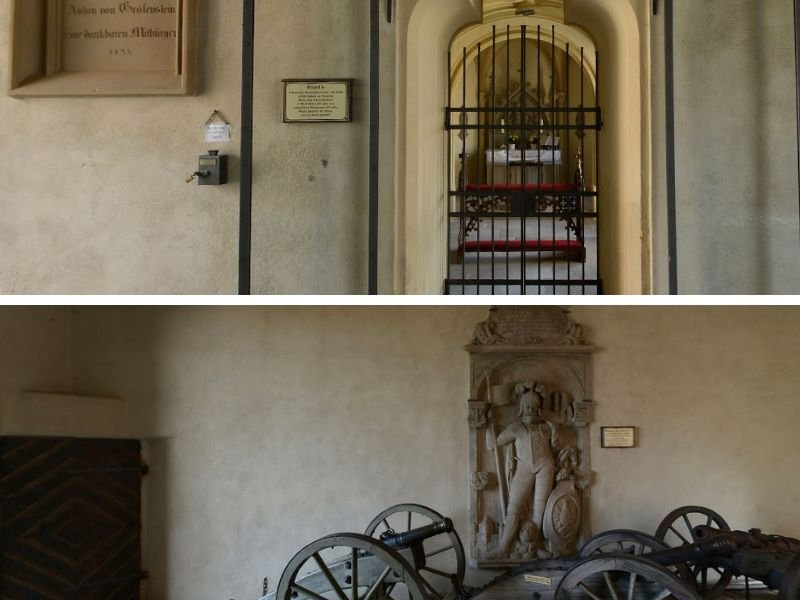
Indeed, as you explore the castle, you can’t help but feel transported back to the medieval era.
You can stroll through the castle grounds, imagining yourself as a medieval guard in the 1200s. Or, you can ascend the bastion and take in the awe-inspiring views of the vast lands and the town from afar.
The castle also houses a restaurant called the “Restaurant Altenburg,” where visitors can relax and enjoy a meal after touring the castle. The restaurant serves delicious meals and beers after a pleasant walk in the castle. They prepare Pork schnitzel, Currywurst, Meat cake, Göttingen, etc.
How to get to Altenburg Castle? It is conveniently located just a 10-minute drive from Old Town Bamberg. If you’re up for a more scenic journey, consider hiking to the castle or taking a bus tour. The castle has several hiking trails all around it anyway.
Alternatively, you can get a bus tour or “hop on, hop off” ride to get to Altenburg from the wooden bridge at Rathaus. You can go to the Tourism Office to ask for the schedule and tickets. You can check the official website of Bamberg for the visiting information for Altenburg Castle.
12. Seehof Palace
Before you leave Bamberg, have a quick visit to Seehof Palace, a stunning summer residence located in Memmelsdorf near Bamberg. It was built in 1686 for the Bamberg Prince-Bishops.
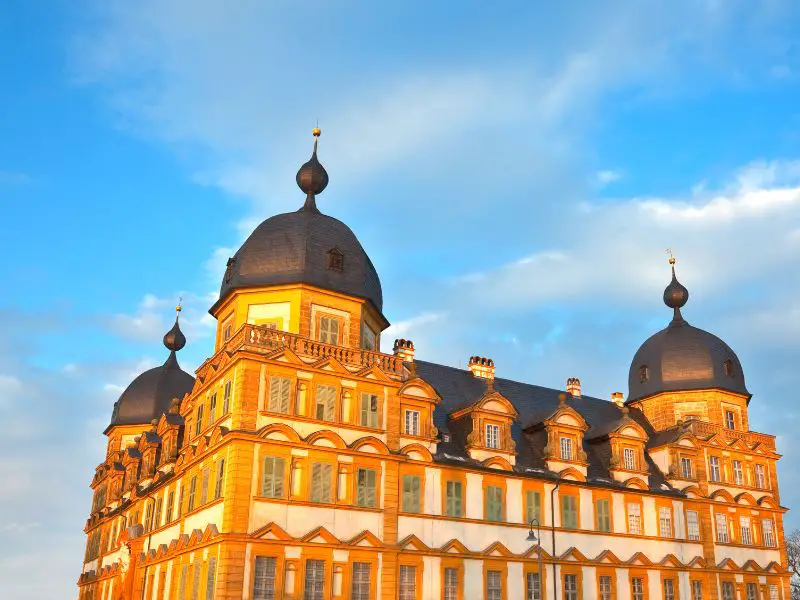
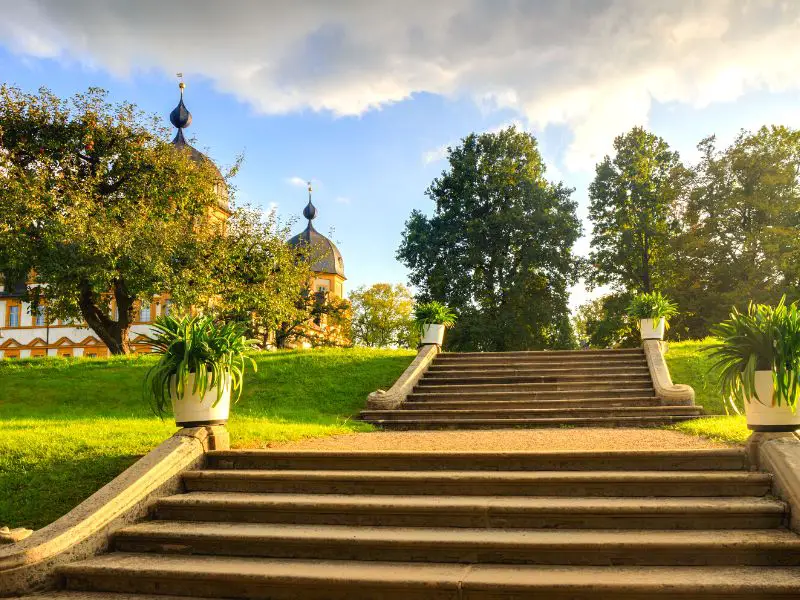
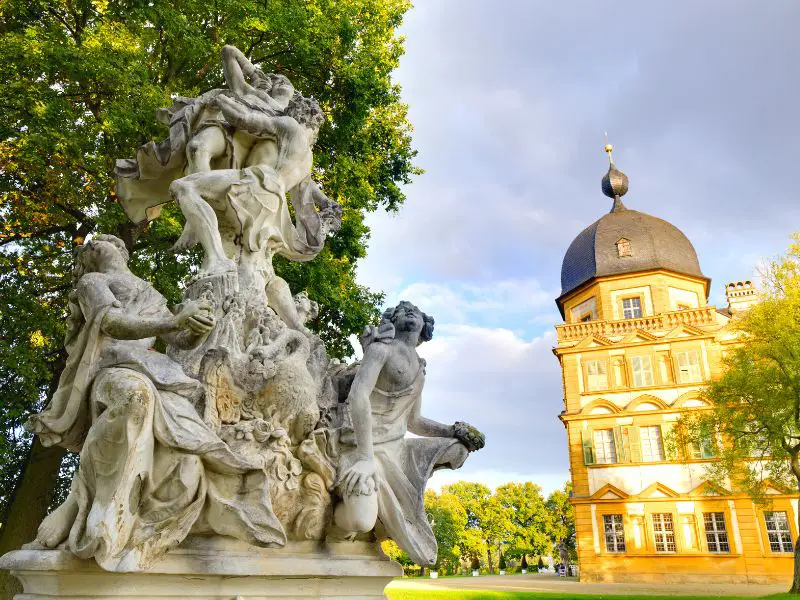
A quick history: Seehof Palace was constructed by Marquard Sebastian Schenk von Stauffenberg, who enjoyed the rural area of Memmelsdorf and commissioned Antonio Petrini to replace a local estate with his own Baroque palace.
After secularization, the palace fell into disrepair under private ownership. However, by the end of the 20th century, extensive renovation work was necessary, and a comprehensive renovation programme has seen much of the residence reverted back to its former glory.
Needless to say — The palace’s architecture is a sight to behold, with its square plan resembling Schloss Johannisburg at Aschaffenburg.
The four corner pavilions of the palace are crowned with squat octagonal towers with projecting roofs, and the facades are cut by large windows with triangular pediments on the ground floor and arches on the upper floor. Each row of windows is supported by a cornice.
Inside, the palace is equally arresting. Nine rooms are accessible, including the White Hall, which counts among its treasures a stunning parquet floor and a ceiling fresco by Guiseppe Appiani. Visitors will also walk through the guardroom, anterooms, and bedrooms on the 45-minute tour.
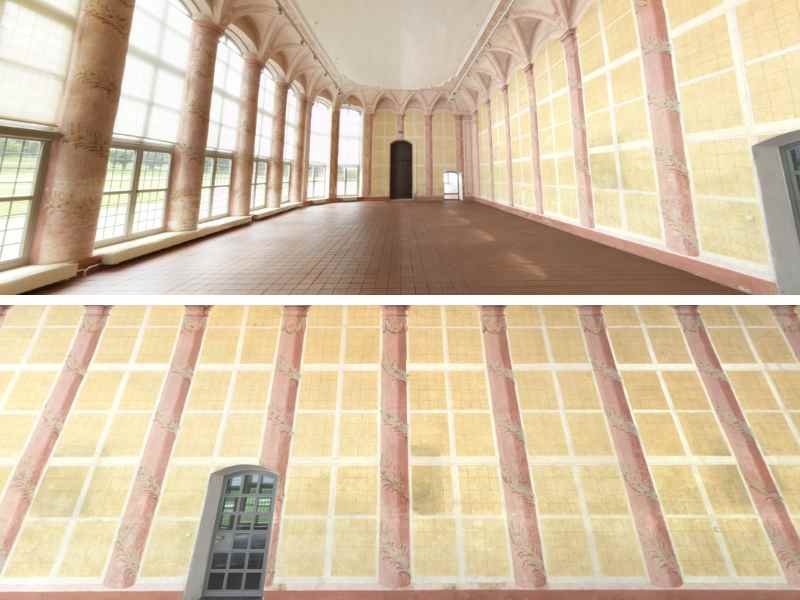
Many people come to Seehof for the gardens, considered in the 18th and 19th centuries to be the most famous Rococo gardens in all of Germany. You can see the same 400 and more stone statues, gargoyles, dragons, grotesques, and myriad mythical creatures that visitors saw 300 years ago.
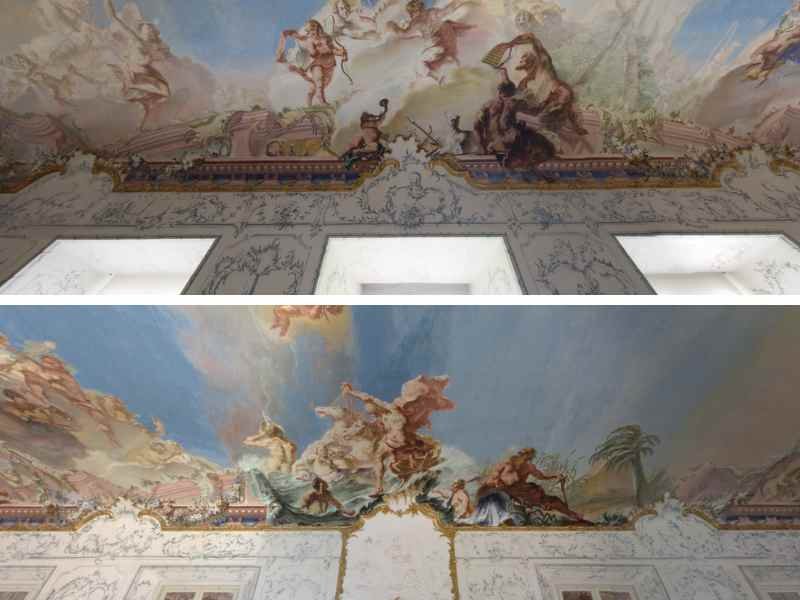
Before visiting, you should consider that large parts of the palace are under renovation. You can only go inside the palace on guided tours at set times. Unfortunately, they do not do any tours in English, and they accept only cash. Tip: to save money, buy a ticket combination of Seehof Palace + New Residence in Bamberg.
If you wish to visit Seehof Palace, don’t forget to check all the important information posted in the official website of Bavarian Palaces Administration Office.
When to Visit Bamberg
Are you considering a trip to Bamberg? Before finalizing your travel dates to this charming city, it’s important to consider certain factors to ensure a rewarding journey. These include the weather and the season, as Bamberg offers several outdoor activities and highlights.
For instance, a romantic gondola ride is best experienced in warm, sunny weather. Moreover, the views from Michaelsberg and the streets of Bamberg are more captivating without the winter overcast.
However, many of Bamberg’s attractions are indoors and can be enjoyed throughout the year, making it a year-round destination. Regardless of the weather, you can visit the Bamberg Cathedral, Neue Residenz, Michaelsberg Abbey, Schlenkerla, Franconian Brewery Museum, and other museums in the town.
To make your visit even more special, consider timing your trip with one of Bamberg’s festivals. These events can certainly add to the memorable experiences in the town. Here is the calendar of events in Bamberg to help you decide the best time for your visit.
How Many Days in Bamberg
While Bamberg may not be as large as Munich, it’s clear that a single day may not be sufficient to fully explore the town given the dozen tourist attractions I mentioned in this post.
Ideally, you might want to allocate two days for a comprehensive experience of Bamberg, or even three days for a more relaxed trip. However, a single day should be enough to cover the highlights of Old Town Bamberg, such as the cathedral, Neue Residenz, Old Town Hall, and the town’s renowned Smoked Beer.
If you’re planning a two or three-day visit to Bamberg, you could spend your first day exploring the streets and key features of Old Town Bamberg. You could visit the iconic Old Town Hall, explore the exhibits and stunning architecture of Alte Hofhaltung and Neue Residenz. In the afternoon, take a boat ride or a romantic gondola trip to see Little Venice. Cap off the day with some beers from the famous Schlenkerla beer house.
On the following day, you could explore Michaelsberg Abbey and visit the Franconian Brewery Museum located within the abbey. Consider having lunch at Michaelsberg to enjoy a meal with a view. In the afternoon, you could visit either Altenburg or Seehof Palace.
You can find the best hotel deals in Bamberg here.
How to Get to Bamberg
Reaching Bamberg from other German cities is quite simple, thanks to the efficient train connections.
If you’re planning to fly, the nearest airport is located in Nuremberg, a city that’s just 60 kilometers away from Bamberg. The train journey between these two cities typically takes no more than 40 minutes. For details such as train tickets and departure times, it’s best to refer to the official website of Deutsche Bahn.
Where to Stay in Bamberg
There are several areas in Bamberg where accommodations can be booked.
- The Old Town, also known as Innenstadt or Altstadt, is a great place to stay due to its proximity to many attractions and a wide range of accommodations. However, it can be crowded and prices might be higher due to the central location.
- Another interesting area is the Bamberg Island or Insel, which is located in the center of the Altstadt. It offers a unique island setting, but accommodations are limited and it can be crowded.
- The Dom Viertel area is also a good place to stay, as it’s close to attractions and less crowded, but it has a limited number of accommodations.
- The middle part of Bamberg, known as Bamberg Mitte, is centrally located with good transportation links, but it can be busy and prices might be higher due to the central location.
- If you prefer a quieter area, Gärtnerstadt is a bit further from the city center and is less crowded, but it’s further from attractions and has fewer dining options.
- The mountainous area of Bamberg, known as Berggebiet, offers beautiful views and a quiet setting, but it’s further from the city center and has fewer accommodations.
- For budget-friendly accommodations, consider hotels like Hotel Europa Bamberg, Ibis Bamberg Altstadt, Ibis Budget Bamberg, Hotel garni Altenburgblick, and Hotel Wohnbar. These hotels offer good value for money and have received positive reviews from travelers.
This hotel browser will certainly assist you if you’re looking for a map to identify the best places to stay in Bamberg.
Getting Around Bamberg
Bamberg is a relatively small town and is quite walkable, especially in the Altstadt or Old Town area. This makes it easy to explore the town on foot.
However, if you’re planning to visit areas outside the city center or if your accommodation is a bit further out, you can rely on the town’s efficient public transportation system. Bamberg has a good network of buses operated by Stadtwerke Bamberg, and there’s also the Central Bus Terminal Bamberg and other bus services like Bus And Fly Taxiunternehmen.
Therefore, you don’t necessarily need a car to get around Bamberg. However, if you’re planning to visit the surrounding areas outside of Bamberg (Altenburg and Seehof Palace), having a car can provide more flexibility.
Tip: The Bamberg Card provides unlimited bus travel within Bamberg and access to the main museums for a period of three days. This could be a convenient and cost-effective way for you to explore the city and its attractions.
Where to Next After Bamberg
If you’re planning a trip to Franconia, including Bamberg in your itinerary is fantastic. But where should you go next? Nuremberg is another excellent destination! It’s quite similar to Bamberg but offers additional attractions such as a museum about the Nazis, a medieval fortress in the city center, and picturesque bridges. Check out my itinerary for Nuremberg.
I would also suggest visiting Rothenburg ob der Tauber and Wurzburg. However, for a change of scenery and a more diverse trip, consider exploring other beautiful locations in southern Germany.
If you enjoy fairytale-like places, relaxing spas, and scenic drives, the Black Forest and its charming towns are worth a visit. Are you traveling around the country using public transportation? consider making a quick stop in Stuttgart before heading to the Black Forest. Stuttgart is home to Mercedes-Benz and Porsche, both of which have museums in the city. These are must-visit attractions if you appreciate modern museums and are a car enthusiast!
On the other hand, if you prefer breathtaking views and wandering in villages with mural-painted facades, the Bavarian Alps is the place to be. There’s so much to do in the Bavarian Alps that a week might not be enough. In fact, if you have the time, I suggest spending 10 days in the Bavarian Alps! But even a week in the Bavarian Alps or three days in the Bavarian Alps can be great if you’re short on time.
During your stay in the Bavarian Alps, you can visit Neuschwanstein Castle (Germany’s ultimate fairytale castle), Oberammergau (known for its Passion Play), Garmisch-Partenkirchen (a town with a rich Olympic heritage), Mittenwald (a charming village filled with Lüftlmalerei), and Berchtesgaden (a town surrounded by scenic spots).
Save it on Pinterest.







